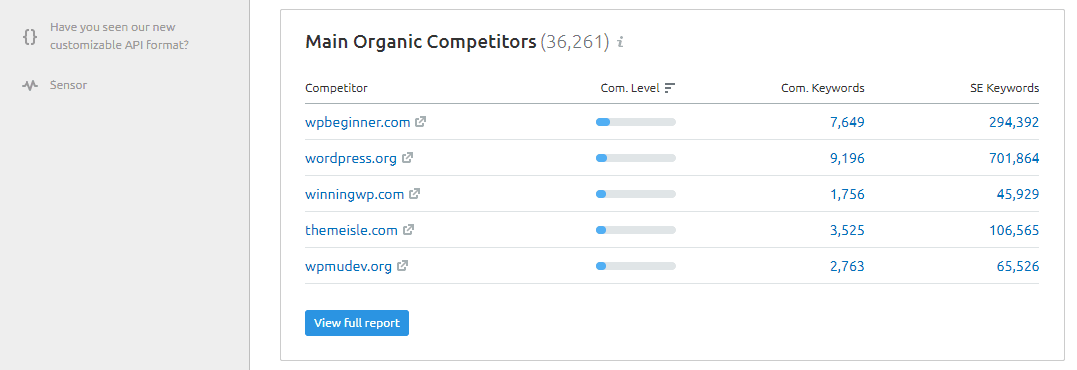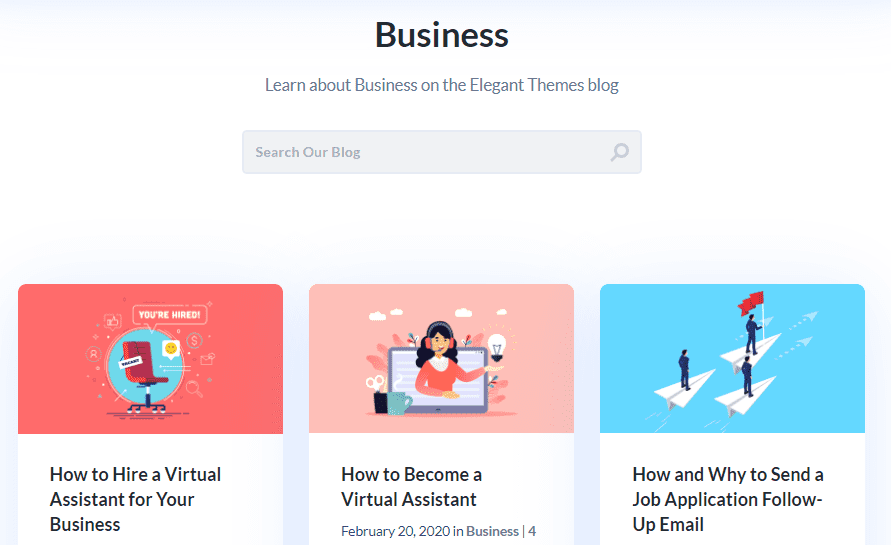Sometimes, the world of blogging feels less like a vast sea and more like a crowded pool. Most niches are so saturated that it takes months or even years to build a loyal audience. If your page views have plateaued, it may be time to consider alternative methods such as the blue ocean strategy.
In this post, we’ll discuss how to change the way you approach blogging and revitalize your website using the blue ocean strategy.
Let’s get to work!
An Introduction to the Blue Ocean Strategy
The blue ocean strategy was developed by Chan Kim and Renee Mauborgne. In a nutshell, this technique focuses on edging into new markets your competitors haven’t yet entered in order to capture the attention of untapped audiences.
These new markets are the titular “blue oceans”, while those your competitors have already saturated are “red oceans”. With a few adjustments, you can adapt this strategy to apply to blogging.
In the past, it was relatively easy to move your posts up the ranks in search engine results. Now, if you’re targeting congested niches and popular keywords, you have to fight tooth and nail to place higher than other blogs in your field.
It is possible to find success in a red ocean. However, in many cases, the smart move is to turn to other methods of setting your content apart and attracting readers.
For example, a blue ocean blog might use innovative content formats or cover topics its competitors avoid. Even if your posts don’t outrank others in Google, readers might be attracted to your premium-quality guides. Writing about subjects adjacent to your niche can help bring new audiences to your site.
That may sound fantastic. However, as you might imagine, pristine blue oceans aren’t usually the kind of thing you stumble upon accidentally. To discover new, untapped markets and reap their full benefits, you need to think outside the box.
How to Use the Blue Ocean Strategy to Revitalize Your Blog (In 4 Steps)
It’s easy enough to say, “Don’t do what every other blog is doing”, but putting that advice into practice is trickier than it sounds. Below, we’ve outlined four steps you can take to pin down opportunities your competitors haven’t touched yet.
Step 1: Research Your Competitors’ Strategies to Find Your Niche’s Red Oceans
Right now, you may be neck-deep in a red ocean without even knowing it. However, you’re probably surrounded by plenty of other blogs in the same situation.
The first thing you want to do is identify your top blogging competitors so you can analyze their strategies. You probably already know some of them. However, it’s always smart to back up any hypothesis with data. A simple way to do this is by using a tool such as SEMrush:

With SEMrush, you can analyze your domain and see a breakdown of its primary organic competitors. This list consists of sites that are ranking for similar keywords:

Next, take a look at each of your competitor’s websites. Check out their blogs and make notes of the following:
- What types of articles appear in their “Popular Posts” section (e.g., tutorials, roundups, etc.)?
- How long are most of their posts?
- Do their titles tend to follow certain formats?
- What topics and keywords do they tend to focus on?
- Are they resorting to clickbait to lure readers in?
Chances are if you asked the same questions about your own site, the answers would be quite similar. It’s common to find a lot of overlap across blogs in the same niche when it comes to content strategy. These areas are the red oceans you want to avoid.
Note that this doesn’t mean strategies such as keyword targeting and headline optimization never work. They’re just what everyone else is doing. To apply the blue ocean strategy to your site, you’ll need to find ways to deviate from the script.
Step 2: Cover Aspects or Topics None of Your Competitors Are Touching
Often, the simplest way to tap into a blue ocean is to expand your focus to topics that you’ve never covered before. Let’s say, for example, your blog focuses mostly on WordPress tutorials. That’s what you know and what your audience wants, so it makes sense to stick to your strengths.
However, when you focus too much on a narrow niche, you can forget your audience has other interests or pain points. Your competitors have probably done the same.
To build on our earlier example, people looking for WordPress tutorials are probably creating sites for themselves or clients. Within that audience, it stands to reason that many readers could also benefit from content on how to grow their businesses.
There’s no shortage of blogs that supply business advice. However, how many of them overlap with WordPress development and design? We’ve applied this same reasoning to the Elegant Themes blog in recent years:

The market for WordPress content is so competitive, that it was only logical to try to tap into a blue ocean. In our case, that meant expanding into professional development and business-related topics.
If you’ve been blogging for a while, you know better than anyone what your audience wants. That means you probably have a decent idea of what their pain points are. If not, you can always ask them by sending around a survey.
Your goal then is to address specific topics none of your competitors are touching, despite the fact that you share similar audiences. If you can zero in on those subjects, you can draw new readerships to your site.
Step 3: Come Up With New Content Structures
It’s also a smart move to consider coming up with entirely new content structures. If you’ve been focusing only on text posts so far, that means you’re leaving out options such as:
- Infographics
- Video content
- E-books
- Podcasts
- Webinars
Your imagination is the limit. Different structures appeal to unique subsets of your audience.
There might be readers who are interested in the topics your blog covers, but aren’t big fans of long-form content. Publishing infographics can help capture their attention and prevent them from defecting to your competitors’ sites.
Similarly, you can reach people with long commutes and little time for reading by launching a podcast. Free e-books may attract those looking for in-depth guides that go beyond what a typical post can cover. The list goes on.
Formats that are untapped by your competitors are prime blue ocean opportunities. That said, you want to focus on types of content that you’re confident you can produce at a high level. Expanding into new structures won’t get you far if you do it poorly.
Step 4: Refine Your Blue Ocean Strategy With Helpful Tools
Breaking new ground is never easy. If identifying and targeting blue ocean markets were simple, all your competitors would be doing it.
Fortunately, there are several existing tools that can help you refine your ideas. Some of our favorites include:
- Buyer utility maps. With utility maps, you can highlight the advantages that your blog currently offers to visitors and see what aspects you’re letting fall by the wayside.
- Eliminate-Reduce-Raise-Create (EERC) grids. The goal of an ERRC grid is to develop a matrix that helps you zero in on aspects of your blog’s strategy you can eliminate and reduce so that you can focus on innovative approaches.
- Strategy canvases. Ideal for helping you pinpoint blue ocean opportunities. A strategy canvas compares the current areas your niche competes in and the readers they attract with alternative strategies and the potential audiences they could draw in.
Ultimately, a big part of identifying blue oceans boils down to two factors. You have to understand your blog’s strengths and weaknesses and what your audience wants. If you know that, then you should be able to come up with new ideas to satisfy readers’ needs.
Conclusion
These days, blogging sometimes seems to be less about writing quality content than it is about SEO. To attract an audience, you need to outshine your competitors in every aspect. It’s an approach that works, but it also ignores the fact you don’t need to play by the same rules as every other content creator.
The blue ocean strategy – which we boiled down to four steps – is all about considering new approaches to make your blog unique by:
- Researching your competitor’s strategies.
- Covering topics none of your competitors are touching.
- Coming up with new content structures.
- Refining your blue ocean strategy with helpful tools.
Do you have any questions about the blue ocean strategy? Share them with us in the comments section below!
Article thumbnail image by United Creative / shutterstock.com









Very interesting article. We’ve experienced a fair amount of success (and increase # of enquiries) by long-tail keyword targeting with vaguely-linked terms to the overall keyword we are trying to get ranked for. Something we have struggled with though is justifying the ROI in the short-term when spent attempting to create content using things like videos and infographics, something that we have not traditionally had much success with.
I like this type of content, I think it is very important to understand this strategy, which presents many techniques to improve the way we analyze the market our businesses, and not only applies to the website we have … but from the way of creating the strategy and manage the branding of our brand
Thank you Oswal! It’s definitely important to approach websites with a business mindset (if you hope to make a business out of it!) and finding blue ocean opportunities is the best way to differentiate yourself from the competition.
SEMrush won’t allow you to do a free trial without entering a credit card number, which to me falls under the category “No way in hell.” Too bad… looked like a neat service.
Agreed. I was hoping there was a free alternative to SEMrush.
Hello Richard! Check out Moz’s free tools – you can get free domain analyses that include a list of your top search competitors (all without having to create an account).
This is a great book and process for ‘zigging’ when others are ‘zagging’! Search the web and there are excel and powerpoint templates available for building your own strategy canvas.
Nice article covering this toolset!
Hello John, I’m glad you enjoyed the article! It’s impressive how many templates and tools there are online to help you identify blue ocean strategies. We couldn’t possibly include all of them, but I hope the ones we mentioned got you off to a good start 🙂